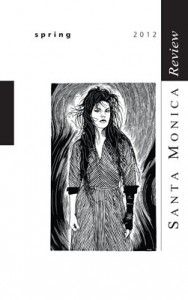 I’m going to review stories from the latest issue of the Santa Monica Review (Spring 2012). This is the first review.
I’m going to review stories from the latest issue of the Santa Monica Review (Spring 2012). This is the first review.
Rhoda Huffey’s “Rima” is a wicked satire of fundamentalist Christian culture, skipping from spinster missionaries to the archeology of Noah’s ark. The story is surreal not only because of its brevity but because of its disjointed paragraphs, with each sentence leaping to a new topic as if flirting with short attention spans. For instance:
“New York is a wicked, wicked city,” she pronounced. exiting the theatre into the bright lights and taxis. Anxious to get back to the hotel, she was worried white slave traders would stick them in the back with needles to make them heroin addicts. Upon her return to Monrovia, she had checked out every book on Evita Peron in the Monrovia library. At the Didwell table, Noah’s stomach growled again. Mrs. Didwell took a spear of turkey and a smidge of dressing, chewed. Ordained, she used to marry the unmarried couples trying to rent apartments as a condition of their tenancy; but that was before the laws changed.”
The first two sentences talk about New York. The third jumps both in place (Monrovia) and in topic (library books). The fourth brings us back to the family meal. So the sequence of those first four sentences is like a concentric circle, starting wide and narrowing closer and closer until we are actually inside a body. The last sentence switches to family history, continuing the technique.
You can only get away with this hopscotching between topics by means of repetition. So in the two previous paragraphs before this quote, one sentence in each one references Evita Peron. We’ve already heard multiple references to Noah’s hunger, and the marriage of unmarried renters links up to all the other passages demonstrating the fundamentalist culture.
A story like this shows how paragraphs can be unified even without sentences linked up to each other like boxcars. The sentence isn’t linked to the previous sentence and the forthcoming sentence, it’s linking to a sentence in the paragraph before and a sentence two paragraphs after. Not only does this structure create the type of energy present at a large family gathering, with seemingly disparate information zinging about from a dozen mouths and bodies, it also allows for a dry, acerbic tone perfect for satire.
This hopscotching is a helpful technique if you find yourself enslaved to a limited way of viewing the connections between sentences and paragraphs. If you want to see more of Rhoda Huffey’s work, check out her novel “The Hallelujah Side,” which seems to cover similar ground as this story.

3 comments
I’m curious to get your reviews on stories from other So Cal literary magazines like SCR and Black Clock. Keep up the great work!
Send me review copies.
While the hopscotching of topics might be a suitable technique for certain kinds of writing like satire, I find this structure of writing to be devoid of flow. Writings of this nature are kind of hard to follow and might not appeal to many readers as they demand a great deal of concentration.